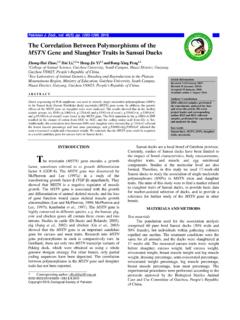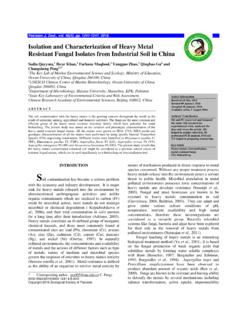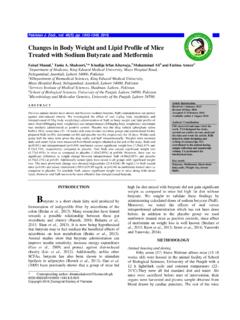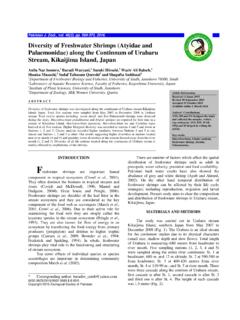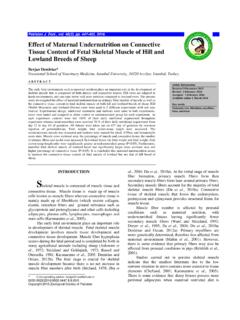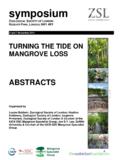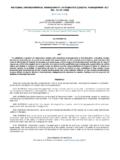Transcription of The Sex Ratio, Gonadosomatic Index, Stages of Gonadal ...
1 Pakistan J. Zool., vol. 45(1), pp. 41-46, 2013. The Sex Ratio, Gonadosomatic index , Stages of Gonadal development and fecundity of Sompat Grunt, Pomadasys jubelini (Cuvier, 1830) Fatimat Adenike Adebiyi* Department of Marine Sciences, Faculty of Science, University of Lagos, Akoka, Yaba, Lagos, Nigeria Abstract. The sex ratio, Gonadosomatic index , Stages of Gonadal development and fecundity of sompat grunt Pomadasys jubelini off Lagos coast, Nigeria were investigated. P. jubelini had sex ratio of 1: (male to female). The difference in sex ratio was not significantly different (p > ) from the expected 1:1 distribution. Gonadosomatic index ranged from to with mean of High Gonadosomatic indices were recorded in July to September, which suggested the spawning period. Only three Stages (quiescent, maturing and mature) of Gonadal development were observed in male and female fish. fecundity ranged from 10,550 to 65,248 eggs with mean of 35,744 626 eggs.
2 This indicated that P. jubelini is a low fecund fish. fecundity and body length and fecundity and body weight were positively correlated. fecundity -length relationship was Log F = + Log L (r = ) and fecundity -weight relationship was Log F = + Log W (r = ). fecundity was more related to length than weight. P. jubelini is a total spawner which spawns during the rainy season in marine and estuarine environments. As a rainy season marine spawner, large total catch can be done during the spawning period and there is abundance of fish seeds, fry and larvae after this period. This makes it cost effective for fish farmers for production of P. jubelini by collection of fish seeds and fry from the wild. The results will increase our knowledge of reproductive biology of P. jubelini which is relevant for fisheries and aquaculture management as well as breeding programmes. Key words: fecundity , Gonadal development , Gonadosomatic index , Lagos coast, Pomadasys jubelini, reproductive biology, sompat grunt.
3 INTRODUCTION Commercial quantities of large numbers of finfish and shellfish are present in the Nigerian coastal waters (Kusemiju et al., 1994). The grunts are among the fish species of great economic importance in the Nigerian coastal waters, off Lagos coast. It is economically important for trawl fishery in Nigeria. It belongs to the family Haemulidae and can be found at depths between 15 and 50m in soft, sandy and muddy bottoms of the coastal waters in the Gulf of Guinea (Mensah and Quaatey, 2002). An important aspect of reproductive biology is fecundity which gives information on the number of eggs in the ovary before the next spawning season (Bagenal, 1978). Studies on fecundity of fish species are pertinent and useful for systematics in racial studies related to total population estimation and productivity. _____ * Present address: Department of Aquaculture, Faculty of Agriculture, Universiti Putra Malaysia.
4 43400 UPM Serdang, Selangor, Malaysia. Tel: +60133325064, Fax: +60389474949. E-mail: 0030-9923/2013/0001-0041 $ Copyright 2013 Zoological Society of Pakistan. Gonadosomatic index which is an index of gonad size relative to fish size is a good indicator of Gonadal development in fish (Dadzie and Wangila, 1980). The percentage of body weight of fish that is used for production of eggs is determined by the Gonadosomatic index . Sex ratio studies provide information on the representation of male and female fish present in a population. It states the proportion of male to female fish in a population and indicates the dominance of sex of fish species in a given population. Sex ratio also constitutes basic information necessary for the assessment of the potential of fish reproduction and stock size estimation in fish population (Vicentini and Araujo, 2003). In estimating the reproductive potential of fish, information on sex ratio of fish can be included to determine female spawning biomass.
5 The addition of sex ratio to estimates of reproductive potential can produce some differences in understanding the status of fish stock in relation to a selected point of biological reference (Morgan, 2008). Information on the reproductive biology of some economically important fish species which include West African Ilisha Ilisha africana, the ADEBIYI 42 croakers Pseudotolithus typus and Pseudotolithus senegalensis off the Lagos coast Nigeria has been reported by some authors (Marcus and Kusemiju, 1984; Anyanwu, 1990). There is paucity of information on the study of reproductive biology of the grunts in the Lagos coast. The reproductive biology of P. jubelini has not been widely reported in literature. The aim of this study was to investigate the sex ratio, Gonadosomatic index , Stages of Gonadal development and fecundity which are some aspects of the reproductive biology of P.
6 Jubelini off the Lagos coast, Nigeria. It is hoped that the information obtained from this study will contribute to our knowledge of the reproductive biology of P. jubelini and will be useful for fisheries and aquaculture production. MATERIALS AND METHODS Study area The Lagos coast was the study area for this research. The Nigerian coastline is between longitude 02 531 to 08 141E and latitude 06 211 to 03 551N, covering a distance of 85km and lies in the Gulf of Guinea. Lagos coast is a narrow coastal shelf and lies between 14, 816km and 27,780km with a total area of 41,000km2. It is a marine environment and salinity is a major limiting factor to the growth of some organisms in the Lagos coast (FAO, 1969; Nwankwo and Onyema, 2003). Collection of specimens and sampling Specimens of P. jubelini were purchased from fish mongers at the landing centre of trawlers fishing off the Lagos coast, at the jetty in Ijora Olopa, Lagos, Nigeria.
7 The specimens were collected from January to September 2005. The fish was identified by using the FAO fish identification manual (FAO, 1981). Simple random sampling technique was used (Cochran, 2007). Fifty samples were randomly selected each month, making a total of 450 samples collected during the study period. The samples were transported to the laboratory and preserved in a deep freezer at -20 C until examination and analysis. Body measurements The specimens were brought out of the deep freezer and allowed to thaw and the body length and weight were measured. Total and standard lengths were measured using a one-meter measuring board graduated in cm. The fish was wiped with a dry napkin before weighing and body weight and ovary weight were measured using a weighing balance (Sartorius model). Sex ratio Each specimen was dissected and the gonads were removed.
8 The sex of each specimen was identified by examination of the gonads. The proportion of the two sexes relative to one another was used to calculate the sex ratio. Gonadosomatic index The Gonadosomatic index was calculated according to Strum (1978) as follows: GSI = weight of gonad x 100 weight of fish Stages of Gonadal development Gonadal Stages were examined macroscopically and classified according to Nikolsky (1963) as follows: stage I, immature; stage II, quiescent; stage III, maturing; stage IV, mature; stage V, running; stage VI, spent. The number of males and females in the different Stages of Gonadal development were counted and recorded. fecundity estimation fecundity which is the number of ripe eggs in the female prior to the next spawning season was estimated according to Bagenal (1978). Only ovarian developmental Stages III and IV were used for fecundity estimation.
9 fecundity was estimated through sub-sampling by gravimetric method. The gonad weight of the fish was measured before preservation in Gilson fluid. Preserved gonads, were later washed with water before counting. The eggs were placed in a Petri dish and a subsample of 1g of eggs was measured. Then the number of eggs in the subsample was counted. Five subsamples were taken and the mean value of eggs was used to calculate the total number of eggs in the gonads. Thirty mature ovaries were used for ASPECTS OF REPRODUCTIVE BIOLOGY OF P. JUBELINI 43 fecundity study of P. jubelini. Regression analysis was carried out relating fecundity to size of fish. The relationship between fecundity and size of fish was determined by using the formula F = aXb Where F = fecundity , X = Standard length of fish (cm) or weight of fish (g), a= Regression constant and b= Regression coefficient. The relationship was transformed into a straight line using logarithm, as Log Y = a + b Log X.
10 Statistical analyses Data were analysed using statistical analysis software (SAS ) and Microsoft Excel 2003 software. Data were expressed as mean standard error of mean. The sex ratio was tested for any deviation from the expected 1:1 ratio by using chi-square analysis. fecundity -length and fecundity -weight relationships were analysed by using regression analysis. The relationship of fecundity with body length and body weight of fish was also analysed by using Pearson s correlation analysis. Level of significance was selected as p < RESULTS A total of 243 males and 207 females were observed out of 450 samples examined. The sex ratio was 1: (male to female). The difference in sex ratio was not significant (p > ). The Gonadosomatic index of P. jubelini ranged from 0. 07% (in a fish of standard length and body weight ) to (in a fish of standard length and body weight ).

